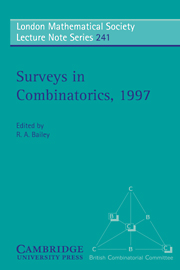Book contents
- Frontmatter
- Contents
- Preface
- M13
- The Harmonious Chromatic Number and the Achromatic Number
- Computer Construction of Block Designs
- Finite Quasiprimitive Graphs
- Tree Width and Tangles: A New Connectivity Measure and Some Applications
- Minor-monotone Graph Invariants
- Some Applications of Algebraic Curves in Finite Geometry and Combinatorics
- New Perspectives on Interval Orders and Interval Graphs
- Approximate Counting
- Author Index
- Subject Index
Computer Construction of Block Designs
Published online by Cambridge University Press: 29 March 2010
- Frontmatter
- Contents
- Preface
- M13
- The Harmonious Chromatic Number and the Achromatic Number
- Computer Construction of Block Designs
- Finite Quasiprimitive Graphs
- Tree Width and Tangles: A New Connectivity Measure and Some Applications
- Minor-monotone Graph Invariants
- Some Applications of Algebraic Curves in Finite Geometry and Combinatorics
- New Perspectives on Interval Orders and Interval Graphs
- Approximate Counting
- Author Index
- Subject Index
Summary
Summary This paper uses an extended example to illustrate how to put together a BDX program to construct block designs fixed by an automorphism, given its orbit matrix. It shows how to specify the parameters and the structural information of the designs. It discusses the symmetry group of the problem and isomorph rejection. It explains how to choose a good order of generation to minimize the size of the search. It also shows how to estimate the size of a search and how to partition the problem into subproblems which can be searched in parallel on several computers.
Introduction
In a recent paper that I co-authored [1], we wrote:
“For each orbit matrix, we used the BDX program to try out all possible circulant matrices with the correct row sum.”
Here, I would like to expand on this sentence, not so much to bore you with details, but to use it as an example to explain how to use the BDX program. This paper is intended as a companion to the BDX reference Guide [7], which is a dry document outlining the syntax and meaning of each of the BDX commands. In this paper, I shall illustrate how the commands can be put together to solve a real problem.
Let me first state what problem we are trying to solve. We want to find all quasi-symmetric 2-(28,12,11) designs with intersection numbers 4 and 6, which are fixed by an automorphism of order 7 without fixed points or fixed blocks.
- Type
- Chapter
- Information
- Surveys in Combinatorics, 1997 , pp. 49 - 64Publisher: Cambridge University PressPrint publication year: 1997



